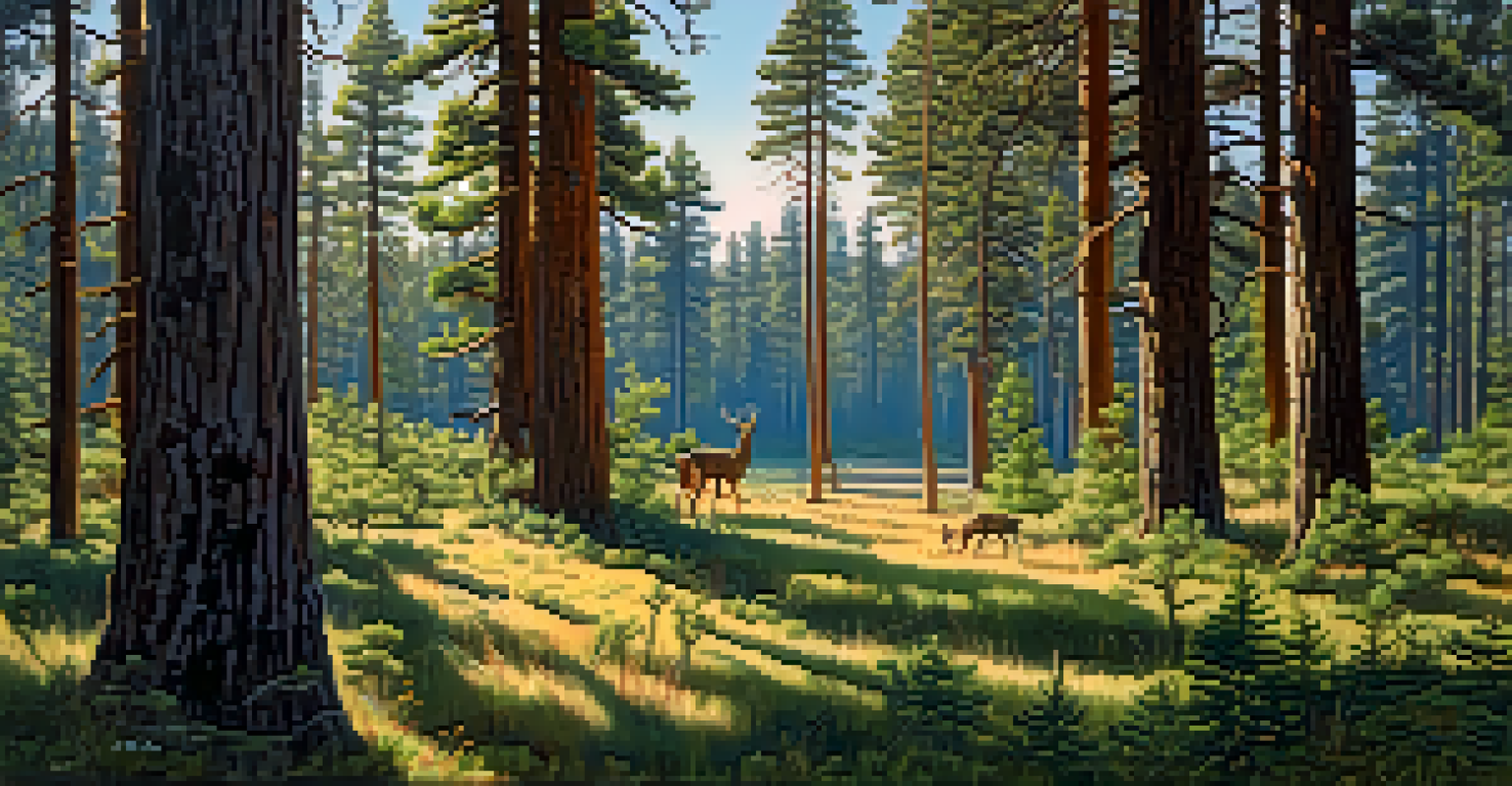Arizona's Unique Ecosystems and Their Importance to Wildlife

Overview of Arizona's Diverse Ecosystems
Arizona is renowned for its stunning landscapes, ranging from towering mountains to vast deserts. This state is home to several unique ecosystems, including the Sonoran Desert, ponderosa pine forests, and riparian zones. Each ecosystem supports a variety of flora and fauna adapted to its specific climate and geography.
In every walk with nature one receives far more than he seeks.
For instance, the Sonoran Desert, with its iconic saguaro cactus, thrives in arid conditions, making it a hotspot for specialized wildlife. In contrast, the lush ponderosa pine forests provide a cooler, wetter environment that supports different species. Understanding these ecosystems helps us appreciate the intricate balance of life they sustain.
The diversity of ecosystems in Arizona is not just a matter of beauty; it plays a crucial role in maintaining the health of the environment. Each ecosystem contributes to the overall biodiversity, providing habitats for countless species and ensuring ecological resilience.
The Sonoran Desert: A Hotspot for Biodiversity
The Sonoran Desert is one of the most biologically diverse deserts in the world, boasting over 2,000 plant species and a rich array of animal life. This ecosystem is characterized by its unique flora, including the famous saguaro cactus and various desert wildflowers. These plants have adapted to extreme temperatures and scarce water resources, showcasing nature's resilience.

Animal life in the Sonoran Desert is equally fascinating, with creatures such as the Gila monster, desert tortoise, and numerous bird species calling it home. These animals have developed unique survival strategies, like nocturnal behavior or burrowing, to cope with the desert's harsh conditions. Each species plays a vital role in the ecosystem, contributing to its overall health.
Arizona's Ecosystems Foster Biodiversity
The diverse ecosystems in Arizona, including deserts, forests, and riparian zones, provide essential habitats for a variety of wildlife, contributing to the state's rich biodiversity.
The importance of the Sonoran Desert extends beyond its beauty; it serves as a critical habitat for wildlife that relies on its unique resources. As urban development encroaches on these areas, protecting this ecosystem becomes imperative for the survival of many species.
Ponderosa Pine Forests: A Rich Habitat for Wildlife
Arizona's ponderosa pine forests provide a stark contrast to the surrounding deserts, offering cooler temperatures and abundant moisture. These forests are home to diverse wildlife, including deer, elk, and various bird species. The lush understory of shrubs and wildflowers also supports smaller mammals and insects, creating a vibrant ecosystem.
The clearest way into the Universe is through a forest wilderness.
The unique structure of ponderosa pine forests, with their tall trees and open canopies, allows sunlight to reach the forest floor, promoting the growth of understory plants. This diversity of plant life creates a rich habitat, providing food and shelter for a variety of wildlife. The interconnectedness of species in this ecosystem highlights the importance of preserving these forests.
As climate change and human activity threaten these habitats, it is crucial to implement conservation efforts. Protecting Arizona's ponderosa pine forests not only benefits the wildlife that inhabit them but also helps maintain the ecological balance of the region.
Riparian Zones: Lifelines for Wildlife
Riparian zones, the interfaces between land and water, are some of the most productive ecosystems in Arizona. These areas are typically found along rivers, streams, and lakes, providing essential habitats for a variety of wildlife. The lush vegetation in riparian zones supports birds, mammals, and aquatic species, making them critical for biodiversity.
In Arizona, these zones serve as vital corridors for wildlife movement. They provide food, shelter, and breeding grounds, making them essential for many species, including endangered ones. The health of riparian ecosystems directly impacts the overall well-being of wildlife populations in the region.
Climate Regulation Through Ecosystems
Arizona's ecosystems play a crucial role in climate regulation by storing carbon, producing oxygen, and influencing local weather patterns.
Conservation of riparian zones is vital, especially in the face of water scarcity and habitat destruction. Efforts to restore and protect these areas not only benefit wildlife but also enhance the resilience of the ecosystem, ensuring it can withstand environmental changes.
The Role of Arizona's Ecosystems in Climate Regulation
Arizona's ecosystems play a significant role in climate regulation, helping to mitigate the effects of climate change. Forests, deserts, and wetlands all contribute to carbon storage and oxygen production, essential for maintaining a balanced atmosphere. Healthy ecosystems can absorb carbon dioxide, reducing greenhouse gases and improving air quality.
Moreover, these ecosystems influence local weather patterns and water cycles. For instance, forests help retain moisture in the soil, which can lead to increased rainfall in surrounding areas. This natural regulation is crucial for maintaining the ecological balance and supporting wildlife.
As climate change poses increasing threats to these ecosystems, understanding their role becomes more important than ever. By prioritizing conservation efforts, we can enhance the resilience of Arizona's ecosystems and ensure they continue to support both wildlife and human communities.
Threats to Arizona's Unique Ecosystems
Despite their importance, Arizona's ecosystems face numerous threats, including urban development, climate change, and invasive species. As cities expand, natural habitats are often destroyed or fragmented, putting pressure on local wildlife populations. This loss of habitat can lead to declines in biodiversity and disrupt the delicate balance of these ecosystems.
Climate change poses another significant challenge, as rising temperatures and altered precipitation patterns affect the resilience of these ecosystems. Species that cannot adapt quickly enough may face extinction, further diminishing the rich biodiversity of the region. Conservation efforts must address these challenges to protect Arizona's unique ecosystems.
Conservation is Vital for Sustainability
Conservation efforts are essential to protect Arizona's unique ecosystems from threats like urban development, climate change, and invasive species.
Invasive species also threaten the integrity of native habitats by outcompeting local flora and fauna. These non-native species can disrupt food webs and lead to declines in native populations. To combat these threats, a concerted effort is needed to promote awareness and implement effective conservation strategies.
Conservation Efforts for Arizona's Ecosystems
Conservation efforts in Arizona are crucial for protecting the state's unique ecosystems and the wildlife that depend on them. Various organizations and agencies are actively working to restore habitats, combat invasive species, and promote sustainable land use practices. These initiatives are essential for maintaining the ecological health of the region.
Community involvement plays a vital role in conservation efforts. Local residents can participate in restoration projects, educational programs, and advocacy initiatives to raise awareness about the importance of protecting Arizona's ecosystems. By fostering a sense of stewardship, communities can help ensure the sustainability of these natural treasures.

In addition to grassroots efforts, state and federal policies are essential for effective conservation. Legislation aimed at protecting endangered species and preserving natural habitats helps create a supportive framework for ongoing conservation initiatives. Together, these efforts can help safeguard Arizona's unique ecosystems for future generations.